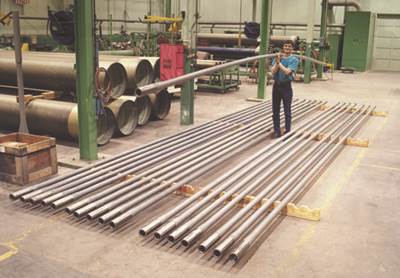Composite Auxiliary/Choke And Kill Lines
In 1998, Stewart and Stevenson (Houston), a manufacturer of risers, BOPs, valves, and other offshore components, approached Lincoln Composites with the idea of developing composite auxiliary/choke and kill lines. Lincoln’s business development manager Doug Johnson says that standard metallic riser joints with
Share
In 1998, Stewart and Stevenson (Houston), a manufacturer of risers, BOPs, valves, and other offshore components, approached Lincoln Composites with the idea of developing composite auxiliary/choke and kill lines. Lincoln’s business development manager Doug Johnson says that standard metallic riser joints with composite choke and kill lines (3.5 to 4 inch/89 to 102 mm ID, 6 inch/152 mm OD) can be substituted one-for-one in place of all-steel riser joints in a deepwater riser system. The brackets, the pin and the box arrangement are the same, and even the buoyancy modules are interchangeable.
Louis Slaughter, marketing manager for the Petroleum Division of Stewart and Stevenson, says that composite auxiliary/ choke and kill lines are ideal for vessels on the deepwater edge that could be adapted for drilling in 6,000 ft of water without undergoing major upgrades. With a lighter riser string, a rig could step out into deeper water without additional riser tensioners. Slaughter said he estimates the value of the weight savings on a deepwater vessel, all factors considered, is in the neighborhood of $7 to $10 per pound. Both Lincoln Composites and Stewart and Stevenson believe that this project could be the springboard for wider introduction of composites technology for offshore use.
To test the design of the metal/composite interface, the composite tubulars were subjected to a burst test at Stress Engineering’s labs in Houston and, says Slaughter, the interface surpassed applicable API standards for flexible choke and kill lines (Section 9.14.12.2 of API Spec 16C, see Sidebar).
The design also underwent a series of fatigue tests, including cycling between 15,000 psi and zero pressure for the equivalent of a 20-year life cycle. A test is now underway to determine how the materials will perform when exposed to a variety of compounds, including hydrogen sulfide, carbon dioxide, diesel oil, and a variety of drilling muds under pressure.
Once these lab tests are concluded, Slaughter says Stewart and Stevenson would like to field-test the design, mainly to test for erosion resistance within the lines. Assuming all goes well, the product will be on the market in late 2002.
ABB Vetco Gray has also fabricated samples of auxiliary/choke and kill lines for testing purposes. These carbon fiber tubulars were lined with thermoplastic that was tested in conditions simulating 80 years of service life before it was combined with the composites and tested as a unit. The 4.5 inch/114 mm ID lined tubulars also have an exterior rubber-based cover for added durability.
Read Next
Composite Drill Pipe An Available Option
Lincoln has been producing flexible composite drill pipe for short-radius, horizontal drilling since 1991. Its nominal 2.375 inch /60.3 mm (OD), 30 ft/9m long pipe shaft is filament wound with 12K carbon fiber combined with glass fibers in epoxy resin over an elastomeric liner. Standard API rotary shoulder too
Read More






.jpg;maxWidth=300;quality=90)







